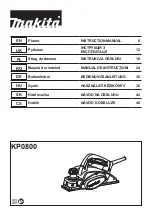
2
Specifications ............................................................................ 1
1. SERVICING NOTES
................................................... 3
2. GENERAL
Locating the Controls ......................................................... 3
3. DISASSEMBLY
3-1. Upper Lid ASSY, Cabinet (Upper) Sub ASSY ........... 4
3-2. MD ASSY, Main Board .............................................. 5
3-3. “Motor ASSY (Sled) (M902)”,
Optical Pick-up (DAX-25E),
“Motor ASSY, Turn Table (Spindle) (M901)” ............ 5
4. ELECTRICAL ADJUSTMENS
............................... 6
5. DIAGRAMS
5-1. Block Diagram –CD SECTION– .............................. 9
5-2. Block Diagram –Tuner SECTION– ........................ 10
5-3. Printed Wiring Boards (FJ215 only) –Side A– ......... 11
Printed Wiring Boards (FJ215 only) –Side B– ........ 12
5-4. Printed Wiring Boards (FJ210 only) –Side A– ........ 13
Printed Wiring Boards (FJ210 only) –Side B– ........ 14
5-5. Schematic Diagram –MAIN SECTION (1/4)– ....... 15
5-6. Schematic Diagram –MAIN SECTION (2/4)– ....... 16
5-7. Schematic Diagram –MAIN SECTION (3/4)– ....... 17
5-8. Schematic Diagram –MAIN SECTION (4/4)– ....... 18
5-9. IC Pin Function Description ..................................... 22
6. EXPLODED VIEWS
6-1. Cabinet Section ......................................................... 24
6-2. Optical pick-up Section (CDM-3325ER) ................. 25
7. ELECTRICAL PARTS LIST
................................... 26
SAFETY-RELATED COMPONENT WARNING!!
COMPONENTS IDENTIFIED BY MARK
0
OR DOTTED LINE
WITH MARK
0
ON THE SCHEMATIC DIAGRAMS AND IN THE
PARTS LIST ARE CRITICAL TO SAFE OPERATION.
REPLACE THESE COMPONENTS WITH SONY PARTS WHOSE
PART NUMBERS APPEAR AS SHOWN IN THIS MANUAL OR IN
SUPPLEMENTS PUBLISHED BY SONY.
Flexible Circuit Board Repairing
• Keep the temperature of the soldering iron around 270
°
C during
repairing.
• Do not touch the soldering iron on the same conductor of the
circuit board (within 3 times).
• Be careful not to apply force on the conductor when soldering or
unsoldering.
Notes on chip component replacement
• Never reuse a disconnected chip component.
• Notice that the minus side of a tantalum capacitor may be dam-
aged by heat.
TABLE OF CONTENTS
CAUTION
Use of controls or adjustments or performance of procedures other
than those specified herein may result in hazardous radiation
exposure.
DANGER
Invisible laser radiation when open and interlock failed or defeated.
Avoid direct exposure to beam.
D-FJ210/FJ215
z
UNLEADED SOLDER
Boards requiring use of unleaded solder are printed with the
lead-free mark (LF) indicating the solder contains no lead.
(Caution: Some printed circuit boards may not come printed
with the lead free mark due to their particular size.)
Unleaded solder has the following characteristics.
• Unleaded solder melts at a temperature about 40
°
C higher
Caution: The printed pattern (copper foil) may peel away if
the heated tip is applied for too long, so be careful!
• Strong viscosity
Unleaded solder is more viscous (sticky, less prone to
flow) than ordinary solder so use caution not to let solder
bridges occur such as on IC pins, etc.
• Usable with ordinary solder
It is best to use only unleaded solder but unleaded solder
may also be added to ordinary solder.
FJ-215 :
AC power adaptor (1)
Headphones/earphones with remote control (1)
Rechargeable batteries (2)
Battery carrying case (1)
www. xiaoyu163. com
QQ 376315150
9
9
2
8
9
4
2
9
8
TEL 13942296513
9
9
2
8
9
4
2
9
8
0
5
1
5
1
3
6
7
3
Q
Q
TEL 13942296513 QQ 376315150 892498299
TEL 13942296513 QQ 376315150 892498299



































